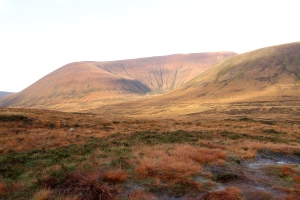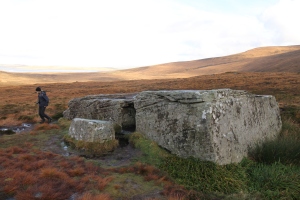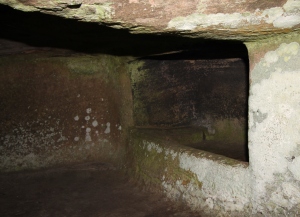?Neolithic 4000 -> 1800 BC
The Dwarfie Stane is an enigmatic rock-cut tomb located on the beautiful island of Hoy in the Orkney Islands. Hoy is the second largest of the islands at 57 square miles and has a wonderfully unspoilt feel to it. The north and west of the island are hilly and reminiscent of the Scottish Highlands and the landscape quite takes your breath away when you first encounter it, particularly on a sunny day when the light and colours look quite magical, as they did on the day I visited. Hoy, meaning ‘High Island’ from the old Norse ‘Haey’, is reached by ferry from Houton on the mainland. A short drive, taking in Betty Corrigall’s grave en route (see link below), brings you to a small, signposted area of off -road parking and across the road a short walk through the heather, much of it boarded, brings you to a large and conspicuous lump of sandstone.
The archaeology bit
The sandstone block measures 8.5 metres long by 4 metres wide and 2 metres high. It is potentially the only example in Britain of a rock-cut tomb. I say ‘potentially’ because its actual origin and purpose is much debated, although the Historic Scotland interpretation sign in situ favours its Neolithic credentials. Unfortunately, there are no reported finds from the site and no excavation has been recorded. Typologically it resembles examples elsewhere in Europe of Late Neolithic rock-cut tombs, such as those in Portugal and Sardinia. Equally though it is thought it could perhaps result from Bronze Age endeavours, and another possibility is that it was a much later Christian hermit’s retreat. Location-wise it would seem to suit all of the above as it is situated alone within a valley amongst imposing hills and beneath a large rocky outcrop known as the Dwarfie Hammars. Its size and stony form stand out within the surrounding expanse of heathland and the Dwarfie Stane would have been easy to locate and impressive within the landscape in prehistoric times, as it is now. Equally, its isolation would have served a hermit well.
Whatever the original purpose of the chamber, it comprises an entranceway measuring around 1 metre square off which there are two chambers, one one either side. The one on the right-hand side notably contains a built-in stone ‘pillow’ resembling those seen in saints’ beds in Northern Italy. It is not known whether all the features of the Dwarfie Stane are contemporary and it has been suggested that the ‘pillow’ was the work of a 19th century stonemason and geologist called Hugh Miller who carved his initials in the right-hand cell during a visit. There is also a large slab of sandstone outside the entrance which previously blocked it and indeed there are records of the tomb having been sealed in the 16th century. Of course, we can’t be sure when it was first blocked or how many episodes of sealing and unsealing there may have been over the centuries or millennia. It is certainly a sizeable block of stone though and moving it would not have been something undertaken lightly (as it were).
If the Neolithic origins are given credence it would have been a hugely impressive feat to have hollowed it out with nothing but stone and antler tools. A supporting view for a Neolithic origin of the stone comes from Audrey Henshall who in the 1950s and 60s, in conjunction with Hampshire-born Professor Stuart Piggott (mentioned in my previous entry on Petersfield Heath), conducted an extensive survey of the chambered tombs of Scotland. She described the Dwarfie Stane as ‘the ultimate devolution within the Bookan sub-group of Orkney-Cromarty chambered cairns, rather than evidence for direct contact with the Mediterranean, where similar tombs exist’.
Over the years many people must have visited the Dwarfie Stane for one reason or another. As well as Mr Miller the stonemason, another known visitor was Major W Mounsey, a former British spy in Afghanistan and Persia, who spent a couple of days and nights there and left his mark in the form of Persian graffiti that can be seen to this day saying, ‘I have sat two nights and so learnt patience’ along with his name in Latin. The stone is even mentioned in Walter Scott’s novel The Pirate.
More recently, the Dwarfie Stane has been included in a study of the acoustics of Neolithic monuments by Dr Aaron Watson and the Monumental Creative Heritage Interpretation team with some interesting results. People listening on the roof of the stone perceived the stone itself to be shaking at some sound frequencies generated within but it is thought this was illusory. Furthermore, loud sounds produced outside the stone echoed ‘like thunder’ in the surrounding landscape. These findings open up fascinating possibilities for how such experiences may have been understood and exploited in the Neolithic and their role within their surroundings. More information on the project can be found via the link below.
Folklore
Legend has it that two giants were imprisoned in the Dwarfie Stane by a third one who wanted to be master of the island of Hoy. However one of the imprisoned giants ate his way out (and in fact the roof has been repaired with concrete, it is thought following a break-in rather than break-out) thus foiling the third giant’s plan. The name Dwarfie Stane has parallels with ‘dwarf stones’ in Iceland and Norway.
Further reading
http://www.caithness.org/caithnessfieldclub/bulletins/1977/april/scottishtombs.htm
http://www.historic-scotland.gov.uk/propertydetail.htm?PropID=PL_113
http://www.hoyorkney.com/VisitHoy/betty_corrigall.html
http://www.monumental.uk.com/site/research/proj/acoustics/dwarfie/html
http://www.orkneyjar.com/history/tombs/dwarfiestane/
canmore.rcahms.gov.uk/en/site/1597/details/hoy+dwarfie+stane/






Thanks for a very interesting post. I visited the Dwarfie Stane a couple of years ago and was very taken with it – a very atmospheric place, and some great tales to go with it!
Thanks for reading. It is a fabulous place, isn’t it, and well worth the effort of getting to it!
What a fascinating place, and with a multitude of possible uses. Slightly reminiscent of Daniel Gumb’s dwelling on Bodmin Moor – http://northstoke.blogspot.co.uk/2014/04/things-to-add-to-daniel-gumb.html
That’s really interesting and, I agree, some similarities! I will definitely have to pay Lumb’s dwelling a visit next time I’m near the Cheesewring (last time I was there, several years ago, I had no idea about it).
It’s a little difficult to find – so too is the nearby Rillaton Barrow. One of our members lives close by, however, should you ever need a guide.
Excellent – I will get in touch when I plan my next Dartmoor trip, thanks!